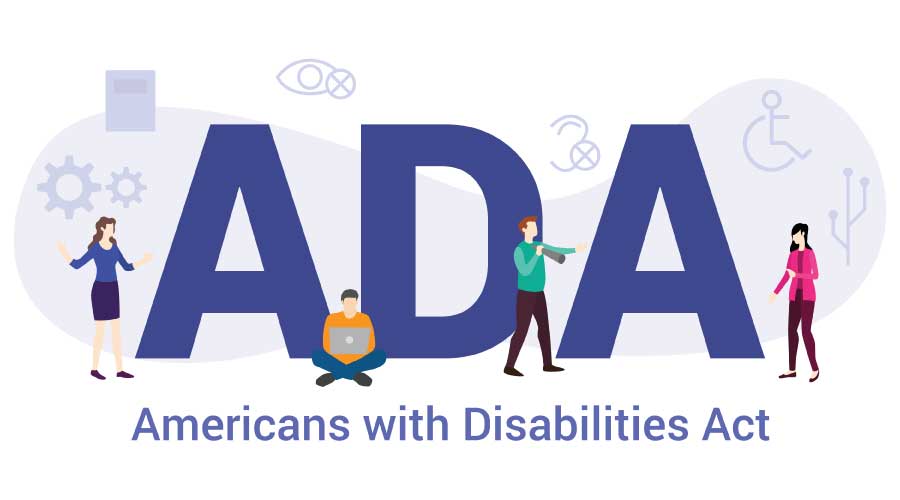How to Avoid ADA Lawsuits
As ADA turns 30 years old, it’s important to remember ADA is about inclusivity, not exclusivity. Here are some tips for FMs to comply with the law.
Did you know your sales and service counter cannot exceed 36 inches in height (34 inches in California)? Did you know that most accessibility litigation begins in your parking lot? Did you know 36 inches is required between your clothing sales racks to maintain an accessible route? The 1990 Americans with Disabilities Act (ADA) matters for all businesses. The law states it is illegal to provide “goods and services to the public” that are not also readily accessible to individuals with disabilities. The ADA protects the rights of individuals with disabilities in all aspects of employment, in accessing public services such as local bus transportation, and guaranteeing access to privately owned establishments (also known as places of public accommodation) such as restaurants, drinking establishments, retail stores, hotels, and even nail salons (including those comfortable spa “foot” chairs).
Today, more than 60 million Americans have a documented disability. According to ADA National Network, disability is defined as a “physical or mental impairment that substantially limits one or more major life activities.”

(Disabled parking space blocked by picnic tables, Longwood, Florida; Image by Susan Berry with Disability Smart Solutions, Florida)
Despite increased awareness and legislation, millions of individuals with a documented disability still experience accessibility challenges related to non-compliance. The ADA prohibits providing goods or services to the public that are not accessible to individuals who have disabilities. It is critically important to recognize that the ADA matters for all business types. Owners of properties and businesses, as well as facilities and leasing managers, should work to comply with ADA and be aware of the potential business impacts of non-compliance.
In addition to traditional, legitimate claims asserted by affected individuals, property and business owners, as well as facility or leasing managers, should be aware of the potential impact by serial litigants, drive-by lawsuits, and cyber lawsuits based on non-compliant elements, features and functions enforceable within the ADA provisions. Settlements can be costly and time consuming, costing thousands of dollars per violation, and can increase quickly into millions. Unfortunately, this trend has been accelerating in recent years. According to Acessible360, during 2016, 262 federal cases were filed just for website accessibility, and by the end of 2020, the number increased to more than 3,500 cases. The increase mostly affected big box and online retailers between 2019 and 2020.

(Disabled access sign posting; image by https://disabilityspeaks.weebly.com/accessibility-fails.html)
In the past, accessibility lawsuits were often brought when disabled individuals encountered physical barriers that prevented access to goods and services. Today accessibility lawsuits not only result from personal physical experience but may be brought fraudulently by individuals with claims for personal gain. Property owners, property managers, and business owners may be unaware of potential liabilities from the multitude of confusing accessibility regulations for a public accommodation facility (e.g., scoping ADA Title I through V, local building codes, WCAG, etc.).
As a building owner or facilities manager, you’ll want to stay on top of Title III of the ADA, which regulates places of public accommodation and commercial facilities – not only for the construction of new facilities, but for existing ones as well. Title III provides that architectural barriers be removed in existing facilities unless doing so is “not readily achievable.”
The ADA defines readily achievable as “easily accomplishable and able to be carried out without much difficulty or expense.”
Additionally, Title III has a safe harbor provision, that states that any portion of a facility built or altered before March 15, 2012, that complies with the 1991 Standards, does not need to be altered. However, there are some facilities that are not included in the safe harbor provision. These include:
- Residential facilities and dwelling units
- Amusement rides
- Recreational boating facilities
- Golf facilities
- Play areas
- Swimming pools
With all of the regulations and exceptions, it is important to hire a trained consultant who can help you determine where barriers are in your facility and if removing them is readily achievable. However, there are a few things you can do today to start making your facility more accessible.
What you can do today
- Your parking lots should have a slope no greater than 2.08 percent. Pavement slopes may change with temperature fluctuations, so climate may be an important consideration in your next parking lot replacement or repair.
- Curb slopes can be no greater than 8.33 percent and curb landings must be level. Curb ramps also are crucial to ensure your building is wheelchair accessible.
- Be sure there is a compliant sidewalk from the public access to the facility.
- Check this site for 1991 ADA Standards or this one for 2010 ADA Standards.
The ADA went into effect 30 years ago, but the accessibility world is still changing today as professionals gain a better understanding and integrate all the different regulations and civil rights laws into their practices. It is critical to engage a professional to navigate the maze of accessibility and understand how to scope a site or building properly to protect resources and avoid costly settlements or litigation. Knowledge and preparation will help property owners, business owners and facilities managers to meet accessibility requirements while avoiding litigation. We need to understand that this is about inclusion and not exclusion. Accessibility is about doing the right thing, and non-compliance with regulations can be costly. If you provide goods and services to the public in a permanent facility or provide online services, take the initiative now while protecting your financial well-being and working to ensure accessibility for all.
Phillip Chuor, CASp #708, ADAC, ICC-PE/BI, TCI-CI is a senior accessibility and ADA specialist based in Terracon’s Nashville office. Registered and licensed as a California Certified Access Specialist (CASp) and also nationally registered as an ADA Coordinator (ADAC). He has more than 20 years’ experience as a senior building plans examiner, combination codes inspector, residential and commercial design, Energy and Green Code construction, and building code consulting.
A Brief History of Disability Rights: How Did We Get to Today?
The disabilities rights movement began as far back as the 1800s. Here are some significant dates in the evolution of this movement:
- In 1817, the American School for the Deaf was founded in Hartford, Connecticut. This was the first school for children with disabilities located anywhere in the western hemisphere.
- In 1919, a nonprofit organization called the National Society for Crippled Children, also known as Easter Seals or Easterseals, was developed to respond to the needs of individuals with a disability and help them reach their full potential.
- In 1935, the League of the Physically Handicapped in New York City was founded by the Works Progress Administration (WPA). Later, the Social Security Act became U.S. law providing federally funded old-age benefits and funds to states for assistance to blind individuals and disabled children.
- In 1961, the American National Standard Institute (ANSI) was published and is still in use today. ANSI oversees a variety of standards that address social responsibilities in the built environment.
- In 1964, the U.S. Congress passed Public Law 88-352 (known as Title VI of the Civil Rights Act of 1964 (42 USC § 2000d et seq.) that prohibits discrimination on the basis of race, color, religion, sex or national origin. The act also includes provisions about race in hiring, promoting and firing.
- In 1968, the Architectural Barriers Act (ABA) became law in the U.S. and required that all federally owned and leased buildings intended for use by the public be accessible to disabled people.
- In 1972, in Mills v. Board of Education of District of Columbia, the U.S. District Court for the District of Columbia ruled that every child, regardless of the type and severity of their disability, was entitled to a free public education.
- In 1973, the Rehabilitation Act prohibited discrimination on the basis of disability in programs offered by any federal agencies, in programs that receive any federal financial assistance, in federal employment and in the employment of federal contractors.
- In 1984, The Uniform Federal Accessibility Standards (UFAS) were developed, specifying the scoping and the technical requirements first required by the Architectural Barriers Act of 1968.
- In 1988, the Fair Housing Act of 1968 was amended to protect people with disabilities from housing discrimination in the areas of rentals, sales and financing, as outlined in the Civil Rights Act of 1968. The amendment also added that reasonable modifications must be made to existing buildings and accessibility had to be incorporated into construction of new multi-family housing units and developments. Then in 1991, the Fair Housing Accessibility Guidelines were developed to provide scoping and technical criteria for compliance with the FHA.
- In 1990, the Americans with Disabilities Act (ADA) became law and provided inclusive civil rights protection for individuals with disabilities. The ADA was modeled after the Civil Rights Act. Section 504 of the Act became the most all-encompassing disabilities rights legislation in American history. The ADA mandated that all local, state, and federal governments and programs be accessible. The ADA is a federal civil rights law, not a set of building codes. The act is simply separated into five important titles: Title I - Employment, Title II - State and Local Government, Title III - Places of Public Accommodations and Commercial Facilities, Title IV – Telecommunications, and Title V – Miscellaneous.
- In 1991, in two separate documents, the U.S. Department of Justice (DOJ) and the U.S. Department of Transportation (DOT) each developed an ADA Standards (ADAS) for Accessible Design, which provided scoping and technical requirements implementing the ADA of 1990. Both the DOJ and DOT adopted the Americans with Disabilities Act Accessible Guidelines (ADAAG) as its standards for ADA Title III for new construction and alterations.
- In 1994, The Uniform Building Code became the first set of building codes to incorporate concepts of the ADAS technical accessibility provisions for new construction and alteration. The building codes are formally adopted by local and/or state government on a three-year cycle.
- Finally, as of September 15, 2010, the Department of Justice published revisions to the regulations of the 1990 ADA Title II and ADA Title III that can be found in the Federal Register. The regulations adopted the newly revised, re-formatted, and enforceable accessibility standards we now call the 2010 Americans with Disabilities Act Standards (ADAS) for Accessible Design. On March 15, 2012, it became effective for new construction and alterations under Title II and Title III.
Related Topics:












